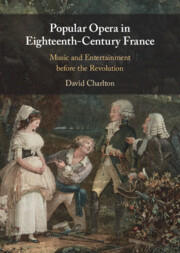Book contents
- Popular Opera in Eighteenth-Century France
- Popular Opera in Eighteenth-Century France
- Copyright page
- Dedication
- Epigraph
- Contents
- Illustrations
- Tables
- Examples
- Preface
- Acknowledgements
- Notes on the Text
- Abbreviations
- 1 Introduction
- 2 Music and Spoken Theatre
- 3 Music in Gherardi’s Company
- 4 Singing and Acting at Home
- 5 Opéra-comique en vaudevilles
- 6 Experiences of Popular Theatre
- 7 Comic and Serious Themes
- 8 Performance as History
- 9 Musical Expansion
- 10 Italian Inroads: The King’s Company
- 11 Six Methods of Synthesis
- 12 A ‘Musico-Dramatic Art’
- 13 Conclusions
- Stage Works Cited
- Bibliography
- Index
11 - Six Methods of Synthesis
Published online by Cambridge University Press: 09 December 2021
- Popular Opera in Eighteenth-Century France
- Popular Opera in Eighteenth-Century France
- Copyright page
- Dedication
- Epigraph
- Contents
- Illustrations
- Tables
- Examples
- Preface
- Acknowledgements
- Notes on the Text
- Abbreviations
- 1 Introduction
- 2 Music and Spoken Theatre
- 3 Music in Gherardi’s Company
- 4 Singing and Acting at Home
- 5 Opéra-comique en vaudevilles
- 6 Experiences of Popular Theatre
- 7 Comic and Serious Themes
- 8 Performance as History
- 9 Musical Expansion
- 10 Italian Inroads: The King’s Company
- 11 Six Methods of Synthesis
- 12 A ‘Musico-Dramatic Art’
- 13 Conclusions
- Stage Works Cited
- Bibliography
- Index
Summary
Chapter 11 concerns the reform of opéra-comique. It reconstructs the inner logic of musical processes in comedies that were all written in reaction to Italian intermezzi. ‘Hybrid Popular Operas’ discusses the first French adaptations of intermezzi: in no case was there a simple process of translation. Pierre Baurans conceived a new genre, comédie mêlée d’ariettes. These adaptations of La serva padrona and Il maestro di musica added new music, and spoken dialogue in verse. C.-S. Favart developed this approach in La Bohémienne and Ninette à la cour, creating dialogued ensembles from solo-voice originals. Rousseau’s Le Devin du village, albeit a court work, innovated through its melodic style, its unconventional forms and its stage directions that were connected to popular practice. Les Troqueurs by Vadé and Dauvergne is then compared and contrasted with Le Devin du village. Egidio Duni’s final opera for Italy, Le Retour au village, is compared with his first for Paris, Le Peintre amoureux de son modèle: their melodic style demonstrably followed Rousseau’s example. Élie Fréron’s published review of Le Peintre amoureux proves that it was understood as a sophisticated exploration of comedic approaches. Using music, aspects of multivocality, orchestration, envoiced memory and stage co-ordination broke new ground.
Keywords
- Type
- Chapter
- Information
- Popular Opera in Eighteenth-Century FranceMusic and Entertainment before the Revolution, pp. 262 - 289Publisher: Cambridge University PressPrint publication year: 2021

